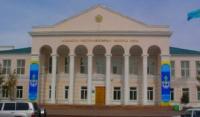Вы здесь
Special Purpose Parts in Astana.

Sights of cities of Kazakhstan.
“We understand the ruins no earlier than ourselves becoming ruins”
Heinrich Heine.
Tours from Astana to Uralsk.
The house in which the Special Forces detachment was formed is located in the old center of the city. The building was built at the beginning of the twentieth century to the Mariinsky gymnasium. The Mariinsky Gymnasium is a women's educational institution whose main goal was “the education of honest and virtuous wives, good housewives, capable of delivering livelihoods for themselves and their families with their works and acquired skills, guardians, nannies, exemplary mentors for children.
Such gymnasiums, which were available in many cities in honor of Empress Maria Feodorovna, were named. The history of this building is connected with the revolutionary period and the civil war. Therefore, in the history of the city this is a house in which special units were formed.
“Special Purpose Units” (CHON), otherwise “communist squads”, (military ¬ party detachments) - were created on the basis of a decree of the Central Committee of the RCP (B) of April 17, 1919, appeared as the fighting forces of the Bolshevik Party, organizationally not included in the Red The army.
They were entrusted with the most urgent and difficult tasks of decisively suppressing thieves, rebellions and other acts of counteraction to the Bolshevik decision. The CHON included communists and sympathetic workers and trade unionists aged 17 to 55, as well as Komsomol youth.
СHAN detachments were created at factory party cells, district committees, city committees and provincial committees of the RCP (b). In 1920 - 1921 A series of Socialist-Revolutionary Kulak rebellions broke out across the country.
In Western Siberia, a rebellion began in Ishim district of the Tobolsk province and quickly spread throughout Kazakhstan. In February 1921, the rebels cut off railway links with Central Russia, destroyed food depots, and killed thousands of Communists and Soviet workers.
Aktyubinsk was declared martial law. By the decision of the district committee of the RCP (b), the revolutionary troika headed by Z.P. led the fight against the gang. Katchenko. Special Forces (CHON) units were urgently formed from among the Communists, Komsomol members, and non-partisans.
In February and early April, units of the Red Army defeated the rebellion known as Petropavlovsk-Prishimsky and restored the situation. Over the years, the building housed the regional committee of the Communist Party of Kazakhstan. 1st City Hospital, Supreme Court of the Republic of Kazakhstan.
City court and court administrator of the city of Astana. In 1921, additional volumes were added to the original construction of the building, some elements were added to the design of the facades, but, in general, it retained its original appearance and a solemnly majestic appearance. In the center of the building stands a large volume of the entrance portal.
The portal is formed using a powerful pediment, based on a colonnade. The extreme columns have a rectangular section, and the central columns have a circular section. The completion of the columns is presented in the form of capitals of the Corinthian order.
The annular space has a semicircular end. The doorway is richly decorated with rustic pilasters and pediment. The planes of the walls of the floors are delimited by classical architectural belts. The walls of the first floor are rusticated.
The window openings of the first and second floors are rectangular in shape, but the height of the windows of the second floor is slightly higher.
Authority:
http://direkt-15.kz/arxitektura/chasti-osobogo-naznacheniya.html
Photos
Alexander Petrov.







